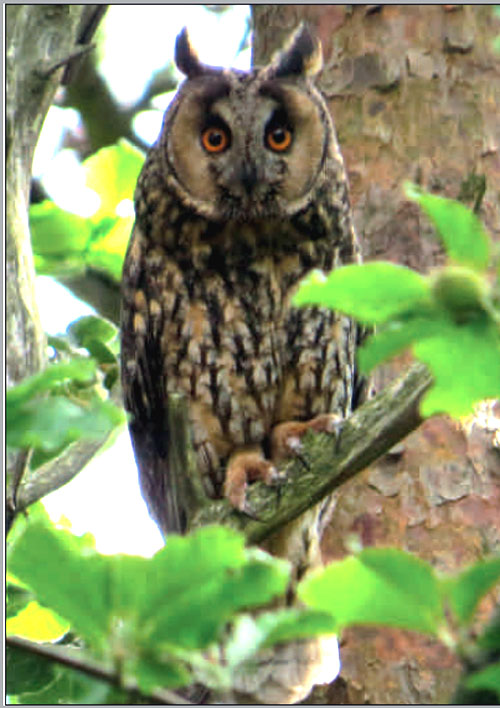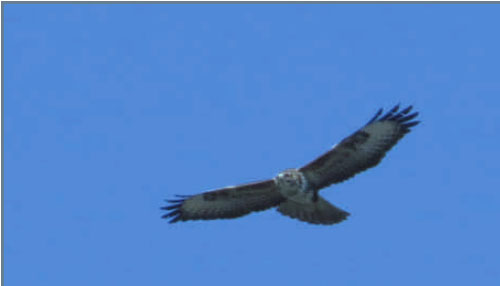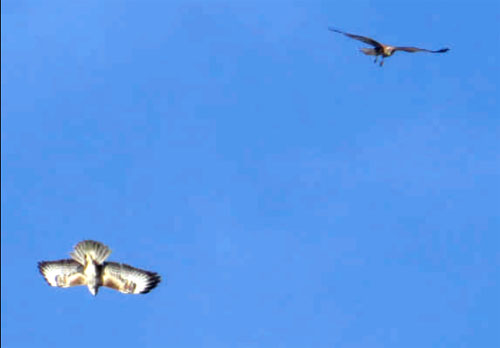| April
/ 2020 - Michael Ryan
|
| Some
years ago I used to regularly visit friends in east County Galway and
would take a diversion over the Slieve Blooms in the hope of seeing
a Hen Harrier flying by, the slopes of the mountains being covered in
heather and forestry at varying stages of growth making the region’s
habitat a stronghold for this rare raptor. Lovely scenery over the mountains
but I never did spot a Hen Harrier on my travels. As I’d wind
down from the mountain range. I’d
pass Kinnity Castle at the base of the mountain range and always thought
it looked an idyllic setting. In February we were going to visit a relative in Offaly and stay over for a night or two. Our usual B&B in Birr didn’t have accommodation on the days we were travelling. It’s overlooking a river and through the floor length window we’ve seen Kingfisher, Grey Wagtail and Dipper as we ate a delicious breakfast last year there was a Spotted Flycatcher nesting directly opposite our bedroom window so we were disappointed we couldn’t stay there but then decided, instead of going for two nights we’d stay in Kinnity Castle for one night. We got to the castle at dusk, and later after dark we went for a walk down the tree lined driveway. Behind the outer fringe of tall conifers lining the drive well spaced beech trees let a little more light into the woods. I randomly pointed my torch into the trees, turned it on and it instantly illuminated a stag sitting on the ground. Lamping is a term used when hunters or poachers dazzle an animal with a powerful torch, usually prior to shooting the unfortunate animal, the theory being the animal will freeze in the light rather then run blindly into the dark. This deer, his head framed with impressive antlers, looked directly at us, I thought more surprised than frightened but then dashed off into the darkness leaving me feeling guilty for disturbing his rest. I wouldn’t be good at differentiating between deer species, which is most reliably done by observing the pattern and colouration on their rear ends, but it was probably a Fallow, the most likely for the area. We heard and saw more deer moving in the gloom and later the receptionist told us they’d often be assembled in front of the hotel in groups of 20 or more as dawn broke. As we returned to the castle Lucy tensed and said she could hear an owl and to my surprise I could hear it too, a deep low hoo hoo call which seemed to be coming from a large solitary standing yew tree nearby. Then an owl flew out from it. For birds whose wing flaps are totally silent they can make surprisingly loud noise by clapping their wings together below their body as they fly, a part of the Long Eared Owl’s mating display, and that was what this individual was doing, wing clapping as it flew in a circle before another owl flew out of the same tree and the pair flew off together. A short walk in the dark had provided us with some nice experiences of nature at night. |
 Female Long Eared Owl the ‘ears’ are in fact feathers Photo: Michael Ryan |
 Leap Day Lizard. Seen on Dalkey Hill on 29th February Photo: Michael Ryan |
The high winds forecast from Storm Jorge for that particular Saturday as we returned from our walk round Dalkey Hill were due to reach the east coast in the early afternoon. The clouds were already moving in and the sun was disappearing fast and you could feel the temperature drop so when Lucy said she’d have a look for lizards above the Vico I thought, good luck with that! Within minutes she’d spotted one. It’s often assumed they always warm themselves on rocks but a lizard on a rock would be very conspicuous to predators like kestrels and cats or dogs so they’re much more likely to be basking on soil blending into the background concealed by grass or plants as this one was. Lizards usually emerge from hibernation in March but this one was already out in February, on the leap year extra day, the 29th, in fact. A few days later in early March, on one of the rare days when there wasn’t strong winds blowing, we’d just got to the top of the hill and stopped beside the Telegraph Tower to look over the bay, the sea flat calm and the blue sky cloudless and actually pleasantly warm in the sunshine. It was the warm air and rising thermals that had four birds soaring above us, broad wings outstretched and effortlessly gliding in slow rising circles. |
| One of the few Irish birds that soar on thermals are buzzards and that’s what these were, four buzzards together. Buzzards are regularly seen on Roche’s Hill and frequent Killiney Golf Course where they’ve been seen plucking rabbits off the course. Sadly rabbits have probably totally disappeared from Dalkey and Killiney Hills so not much potential prey to attract the buzzards but maybe the quarry itself creates a funnel of warm air which helps them rise because six days later I saw three again in the same area. Buzzards have naturally colonised Ireland, moving down from Northern Ireland in comparatively recent years and now breeding in every county in the Republic. Seen beside motorways everywhere they’re almost certainly destined to become our most common bird of prey and on a Birdwatch coach trip to Belfast last November we counted 26 individual birds at various stages. |
 Soon to be probably our most common bird of prey, the buzzard, this one over the quarry Photo: Michael Ryan |

Two of four buzzards flying over Dalkey Quarry together
Images & Text by :- Michael Ryan
DALKEY HOME PAGE | DALKEY COMMUNITY COUNCIL | DALKEY HERITAGE COMPANY | CANNONAID
|
|


